|
|
Cycling the Paso de Jama and Salar Uyuni
Translated by PROMT-Online-Translator
| Country: |
Argentina, Chile and Bolivia |
Tour: |
Paso de Jama to Salar Uyuni |
| Start: |
Jujui (Argentina) |
End: |
Oruru (Bolivia) |
| Route: |
Jujui (Argentinien), Purmamarca (Argentina), Paso de
Jama (Argentina), San Pedro de Atacama (Chile), Calama (Chile), Ollague
(Chile), Salar Uyuni (Bolivia), Oruru (Bolivia) |
| Distance: |
|
Time: |
|
| Support: |
f-sufficiency, tent |
Climbing in meters: |
|
| Difficulties: |
Big distances without water, very strong west winds, high altitude
(up to 4800m), cold nights (to-18Grad)
|
| Rating: |
Supernice high mountain deserts! One of our favorite
areas in South America. |
| Route Argentinien: Salta, San Antoniode los
Cobres, Cafayate, Quebrada de las Conchas |
| |
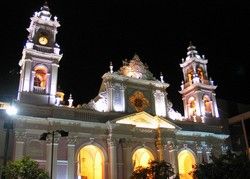 Salta: Salta lies on a altitude
of 1200 m and is a source place for the Argentine Altiplano (high
mountain deserts). Salta should be the nicest town of Argentina according
to guide, and we can only underline this. For us it is the town nicest
up to now of South America. Beside many marvellous old buildings and
churches in particular the quiet and comfortable atmosphere and the
nice inhabitants of the city likes us. Nevertheless, unfortunately,
we deal really a lot before we high on the Altiplano to Chile and
Bolivia cycle (new rim and pedals for Nadines wheel, both Isomatten
mend, map for Bolivia dealt with, compass and hot-water bottles shop,
photos make, bulky Cd's burn...) and thus we cannot enjoy the town,
unfortunately, so extensively. The mechanic of the Nadines back wheel
anew einspeicht is really nice and works even half a siesta by around
it directly on being able to make from what his woman is inspired,
however, less. Before nothing but work and excitement Martin leaves
one more of our memory maps in the Internet cafe, however, as us a
few days later again come she holds out to us the owner quite beaming
with delight. Salta: Salta lies on a altitude
of 1200 m and is a source place for the Argentine Altiplano (high
mountain deserts). Salta should be the nicest town of Argentina according
to guide, and we can only underline this. For us it is the town nicest
up to now of South America. Beside many marvellous old buildings and
churches in particular the quiet and comfortable atmosphere and the
nice inhabitants of the city likes us. Nevertheless, unfortunately,
we deal really a lot before we high on the Altiplano to Chile and
Bolivia cycle (new rim and pedals for Nadines wheel, both Isomatten
mend, map for Bolivia dealt with, compass and hot-water bottles shop,
photos make, bulky Cd's burn...) and thus we cannot enjoy the town,
unfortunately, so extensively. The mechanic of the Nadines back wheel
anew einspeicht is really nice and works even half a siesta by around
it directly on being able to make from what his woman is inspired,
however, less. Before nothing but work and excitement Martin leaves
one more of our memory maps in the Internet cafe, however, as us a
few days later again come she holds out to us the owner quite beaming
with delight. |
| |
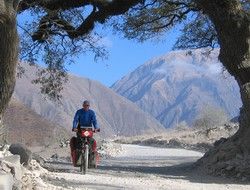 Hostel "Los Cardones": By chance
we have landed in Salta in the really nice Hostel "Los Cardones"
which is led by the Argentine German married couple Belen and Achim.
Since the having here hotel in Cairo we have felt in no other Hostel
we here. Actually, Salta should be only one short Durchgansstation,
however, the both make us so curiously on the Gegegend, so that we
remain a little longer and make a few excursions to the area. For
our second night accommodate to us Achim and Belen then even in the
luxurious double room with own bath and for the bargain price of the
multi-bed room without bath. www.loscardones.todowebsalta.com.ar,
los.cardones.salta@gmail.com Hostel "Los Cardones": By chance
we have landed in Salta in the really nice Hostel "Los Cardones"
which is led by the Argentine German married couple Belen and Achim.
Since the having here hotel in Cairo we have felt in no other Hostel
we here. Actually, Salta should be only one short Durchgansstation,
however, the both make us so curiously on the Gegegend, so that we
remain a little longer and make a few excursions to the area. For
our second night accommodate to us Achim and Belen then even in the
luxurious double room with own bath and for the bargain price of the
multi-bed room without bath. www.loscardones.todowebsalta.com.ar,
los.cardones.salta@gmail.com |
| |
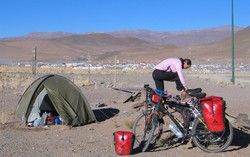 San Antonio de los Cobres: The
valley of Salta to San Antonio de loose Cobres should be especially
nice according to Achim. Because San Antonio on a height of 3800 m
lies we decide to make a small Aklimatisierungstour. Thus we go about
a 4080-m-high pass by the coach to San Antonio where we arrive against
21:00h at floor-dark night. We drive a few metres from the place out
and build up our tent behind truck scales at the stormy night. We
want to try out whether we are prepared with our sleeping-bags for
the cold night temperatures on the Altiplano suitably, Nevertheless
to play it safe we have got another two hot-water bottles now we initiate.
Though we have night frost, because the water in our water bottles
is frozen, however, thus coldly as expected it is not, so that to
us with the hot-water bottles becomes quite hot. San Antonio de los Cobres: The
valley of Salta to San Antonio de loose Cobres should be especially
nice according to Achim. Because San Antonio on a height of 3800 m
lies we decide to make a small Aklimatisierungstour. Thus we go about
a 4080-m-high pass by the coach to San Antonio where we arrive against
21:00h at floor-dark night. We drive a few metres from the place out
and build up our tent behind truck scales at the stormy night. We
want to try out whether we are prepared with our sleeping-bags for
the cold night temperatures on the Altiplano suitably, Nevertheless
to play it safe we have got another two hot-water bottles now we initiate.
Though we have night frost, because the water in our water bottles
is frozen, however, thus coldly as expected it is not, so that to
us with the hot-water bottles becomes quite hot. |
| |
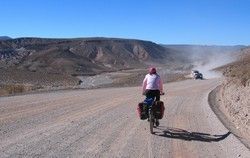 Dreamlike descent I: From San
Antonio de loose Cobres it goes about the 4080-m-high pass 168 km
back to Salta. Nevertheless, to me the height is a little bit too
much and thus the height illness with light headaches and some feeling
of sickness becomes apparent with me. When we of the pass set off,
however, again it is better with rather fast again. Dreamlike descent I: From San
Antonio de loose Cobres it goes about the 4080-m-high pass 168 km
back to Salta. Nevertheless, to me the height is a little bit too
much and thus the height illness with light headaches and some feeling
of sickness becomes apparent with me. When we of the pass set off,
however, again it is better with rather fast again. |
| |
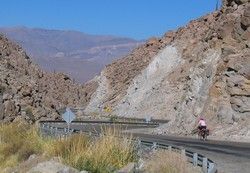 Dreamlike descent II: Achim was
right and thus we cycle by a breathtaking mountain world. In the beginning
though we still deal with a dusty runway, however, then later we receive
asphalt. Dreamlike descent II: Achim was
right and thus we cycle by a breathtaking mountain world. In the beginning
though we still deal with a dusty runway, however, then later we receive
asphalt. |
| |
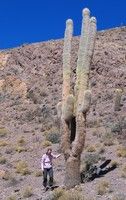 Cacti: Gigantic cacti line here
and there the long departure. Cacti: Gigantic cacti line here
and there the long departure. |
| |
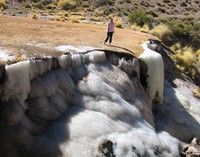 Waterfall: Because it up here
nearly every night strong frost gives it is no miracle that also the
waterfalls are frozen. Waterfall: Because it up here
nearly every night strong frost gives it is no miracle that also the
waterfalls are frozen. |
| |
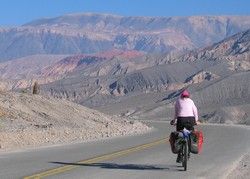 Dreamlike descent III: Ohne Worte Dreamlike descent III: Ohne Worte |
| |
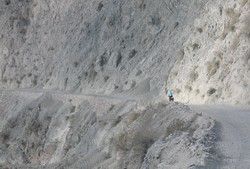 Dreamlike descent III: Without
words Dreamlike descent III: Without
words |
| |
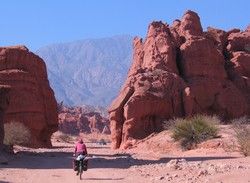 Quebrada de las Conchas:Another
highlight of the area is the Quebrada de read Conchas, a gulch from
Cafayate to Salta leads. Nadine has on the Internet site of Peter,
to a pilgrim's eagle we have hit on Tierra del Fuego whose photo by
the gulch seen and is so inspired that she also wants to see them.
Quite atypical for ourselves we make a small excursion by the coach
again. The coach driver has been surprised a little bit when we him
ask ourselves, nevertheless, 10 km before Cafayate to stop. He means
it, nevertheless, would be quite dark and cold, however, there we
explain to him that, besides, we have not only our wheels but also
a tent equipment, he is calmed. The journey by the Quebrada de read
Conchas the next day then is the absolute dream. For it that it should
go, actually, downhill though it is quite hilly and a taut headwind
allows to become it though no comfortable Radeltag, nevertheless,
regional the distance is really unique. Quebrada de las Conchas:Another
highlight of the area is the Quebrada de read Conchas, a gulch from
Cafayate to Salta leads. Nadine has on the Internet site of Peter,
to a pilgrim's eagle we have hit on Tierra del Fuego whose photo by
the gulch seen and is so inspired that she also wants to see them.
Quite atypical for ourselves we make a small excursion by the coach
again. The coach driver has been surprised a little bit when we him
ask ourselves, nevertheless, 10 km before Cafayate to stop. He means
it, nevertheless, would be quite dark and cold, however, there we
explain to him that, besides, we have not only our wheels but also
a tent equipment, he is calmed. The journey by the Quebrada de read
Conchas the next day then is the absolute dream. For it that it should
go, actually, downhill though it is quite hilly and a taut headwind
allows to become it though no comfortable Radeltag, nevertheless,
regional the distance is really unique. |
| |
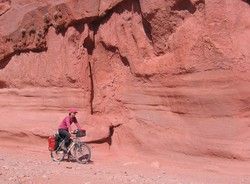 Nadine: Nadine before marvellous
red rock. Nadine: Nadine before marvellous
red rock. |
| |
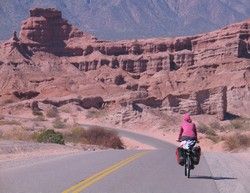 Quebrada de las Conchas II: Without
words Quebrada de las Conchas II: Without
words |
| |
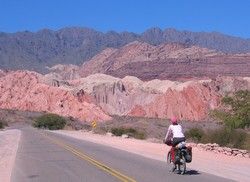 Quebrada de las Conchas III:
The multi colour rocks are still much more impressive in reality than
on the photo! Quebrada de las Conchas III:
The multi colour rocks are still much more impressive in reality than
on the photo! |
| |
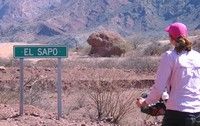 El Sapo: "The toad"! El Sapo: "The toad"! |
| |
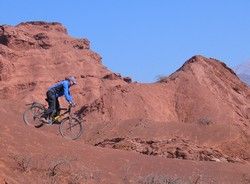 Short Downhill: Martin on a short
excursion to the mountains. Short Downhill: Martin on a short
excursion to the mountains. |
| |
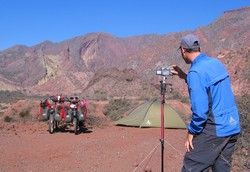 Camp site: For the conclusion
of the day we find a marvellous camp site on a nanny goat path. The
next morning in particular the view is absolutely marvellous. Because
there no suitably high stone is around to hang up the photo we construct
a tripod from a Wanderstecken (the Wanderstecken ordinarily serve
us as a bicycle stand). Camp site: For the conclusion
of the day we find a marvellous camp site on a nanny goat path. The
next morning in particular the view is absolutely marvellous. Because
there no suitably high stone is around to hang up the photo we construct
a tripod from a Wanderstecken (the Wanderstecken ordinarily serve
us as a bicycle stand). |
| |
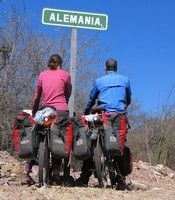 Again at home? The last place
of the Quebrada de read Conchas is Alemania. However, to recognise
easily how on the photo is we have turned towards the native country
still the back, even if we are in principle again on the way home.
:-) Again at home? The last place
of the Quebrada de read Conchas is Alemania. However, to recognise
easily how on the photo is we have turned towards the native country
still the back, even if we are in principle again on the way home.
:-) |
| |
| Route Argentina: Salta, Jujui, Pumarmarca,
Salinas Grandes, Susques, Paso de Jama |
| |
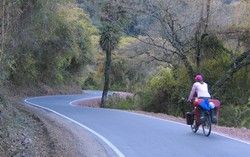 Ascent: From Salta it goes about a
small pass further to Jujui. From the pass it goes easily down by
marvellous woods on winding line on a very narrow street which may
be used neither by Lkws nor by coaches. The marvellous street with
her countless blind curves is for cyclists and motorcyclists a true
dream. Ascent: From Salta it goes about a
small pass further to Jujui. From the pass it goes easily down by
marvellous woods on winding line on a very narrow street which may
be used neither by Lkws nor by coaches. The marvellous street with
her countless blind curves is for cyclists and motorcyclists a true
dream. |
| |
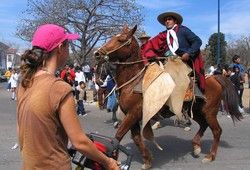 El Exodo Jujeño: In August,
1812 ordered general Belgrano (who wears general in Rosario for the
first time the Argentine flag hoisted) to evacuate the city of Jujui
before the progressing Spanish troops and to destroy. To this unusual
victim during the Argentine independence war is thought yearly 24th
of August with big festivities and Gauchoparaden. We come suitably
to the big Gauchoparade to Jujui and can be present thus at the impressive
play with which laxly during 2 hours a Gauchotruppe rides after the
others. All horses and in particular the riders are dressed up on
the finest one and reflect absolutely only in some cases the actual
prosperity again. Thus ride in the rejoicing amount of "big landowners"
with children, "small farmer" or "Peon" (Agricultural
labourers or farm-hand) past. Beside us a Gaucho which waves with
a little bit sad view to his patron stands just with his children
vorbeireitet. Although the horses are turned up partly completely
what may lie absolutely also with the wild waffenscheinpflchtigen
spores which the riders carry today, they all control rider completely.
One sees quite clear that the horse is here no "sports machine",
but is required for the everyday work. El Exodo Jujeño: In August,
1812 ordered general Belgrano (who wears general in Rosario for the
first time the Argentine flag hoisted) to evacuate the city of Jujui
before the progressing Spanish troops and to destroy. To this unusual
victim during the Argentine independence war is thought yearly 24th
of August with big festivities and Gauchoparaden. We come suitably
to the big Gauchoparade to Jujui and can be present thus at the impressive
play with which laxly during 2 hours a Gauchotruppe rides after the
others. All horses and in particular the riders are dressed up on
the finest one and reflect absolutely only in some cases the actual
prosperity again. Thus ride in the rejoicing amount of "big landowners"
with children, "small farmer" or "Peon" (Agricultural
labourers or farm-hand) past. Beside us a Gaucho which waves with
a little bit sad view to his patron stands just with his children
vorbeireitet. Although the horses are turned up partly completely
what may lie absolutely also with the wild waffenscheinpflchtigen
spores which the riders carry today, they all control rider completely.
One sees quite clear that the horse is here no "sports machine",
but is required for the everyday work. |
| |
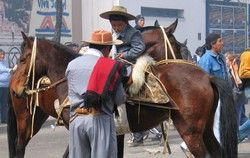 Spores for the younger generation:
Apparently the horse of the son was not as well-behaved completely
as it should be and thus Sohnemann gets without further ado the spores
of the father missed. Spores for the younger generation:
Apparently the horse of the son was not as well-behaved completely
as it should be and thus Sohnemann gets without further ado the spores
of the father missed. |
| |
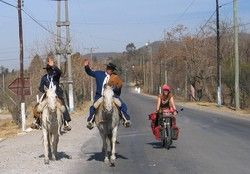 On the way home: While the "big
landowners" load her riding animals after the parade onto trucks
and go again home, we hit on our way to the north over and over again
the "small farmers" who ride now again home. On the way home: While the "big
landowners" load her riding animals after the parade onto trucks
and go again home, we hit on our way to the north over and over again
the "small farmers" who ride now again home. |
| |
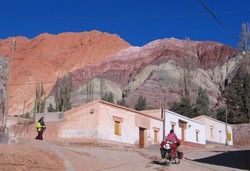 Pumamarca I: 65 km to the north
of Jujui there lies the small place Pumamarca which is famous for
his 7-coloured rock. The paints of the rock look almost quite in a
kitschy way nice in the morning sun and anyhow unsubstantially. Pumamarca I: 65 km to the north
of Jujui there lies the small place Pumamarca which is famous for
his 7-coloured rock. The paints of the rock look almost quite in a
kitschy way nice in the morning sun and anyhow unsubstantially. |
| |
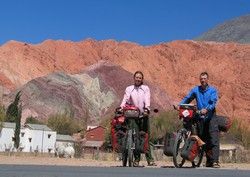 Pumamarca II: After we have
made like all the others also from the view hill from a photo and
had made, besides, the acquaintance of a school class from tablespoon
Carmen we let ourselves on a Mäuerchen in Purmamarca down to
have breakfast first of all comfortably in the face of the coloured
rock. After a short chat with the villagers on the marketplace woollen
things sell and an Argentine here his winter vacation spends we come
along on the way in the mountains. Pumamarca II: After we have
made like all the others also from the view hill from a photo and
had made, besides, the acquaintance of a school class from tablespoon
Carmen we let ourselves on a Mäuerchen in Purmamarca down to
have breakfast first of all comfortably in the face of the coloured
rock. After a short chat with the villagers on the marketplace woollen
things sell and an Argentine here his winter vacation spends we come
along on the way in the mountains. |
| |
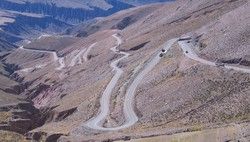 Cuestan de Lipan: From Purmamarca
it goes about the serpentine roads with the name Cuestan de Lipan
about the 4170-m-high Abra de Portrerillos high on the Altiplano,
the big "plateau" (is not really level) in Argentina, Chile,
Bolivia and Peru. To acclimatise us we give time ourselves for the
rise two days, although we could have cycled to tell the truth also
not faster, because we have about 16 litres of water including (there
is on the next 400 km because only one place and a small rivlet).
Our destination is San Pedro of the Atacama in Chile on the other
side of the Andes which we want to cross about the 4200-m-high Paso
de Jama. Cuestan de Lipan: From Purmamarca
it goes about the serpentine roads with the name Cuestan de Lipan
about the 4170-m-high Abra de Portrerillos high on the Altiplano,
the big "plateau" (is not really level) in Argentina, Chile,
Bolivia and Peru. To acclimatise us we give time ourselves for the
rise two days, although we could have cycled to tell the truth also
not faster, because we have about 16 litres of water including (there
is on the next 400 km because only one place and a small rivlet).
Our destination is San Pedro of the Atacama in Chile on the other
side of the Andes which we want to cross about the 4200-m-high Paso
de Jama. |
| |
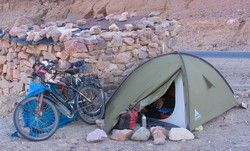 Sandstorm:On top we are pleased
about the pass arrived already on the departure coming now, however,
thanks to tough headwind the joy is clouded a little bit. Then, nevertheless,
the departure becomes unsightly when the taut headwind develops to
the sandy storm. Though we are only on the edge of the sandy storm
and the sand to us around the ears flies still keeps to a certain
extent, however, the wind is so strong meanwhile that we are not able
to cycle downhill partially any more separate must push! Exactly at
this moment a spoke in the back wheel breaks with Nadine. Little successful
we try to find behind a small sandy hill protection to trade the spoke.
Because we have luckily no experience, nevertheless, with broken spokes
(it is the second spoke break in more than 56,000 km) we need of course
quite long to us the new spoke, finally, in it have. The valley lying
before us that we could still see good from the pass has disappeared
meanwhile in a gigantic sandy cloud, so that we reach for seeing that
it will probably be the best as quickly as possible on a more or less
protected place our tent to be based. After we have examined some
street passages and have not considered, however, good we whip our
tent, finally, after just 28 km, behind a sort of coach small house.
With pleasure we would have gone in to the small house, however, unfortunately,
this was already abused as a toilet. Almost the whole night there
raves the storm, however, the next morning we have again the nicest
weather and only one light pinch, to us on the departure to the Salinas
Grandes entgegenweht. Sandstorm:On top we are pleased
about the pass arrived already on the departure coming now, however,
thanks to tough headwind the joy is clouded a little bit. Then, nevertheless,
the departure becomes unsightly when the taut headwind develops to
the sandy storm. Though we are only on the edge of the sandy storm
and the sand to us around the ears flies still keeps to a certain
extent, however, the wind is so strong meanwhile that we are not able
to cycle downhill partially any more separate must push! Exactly at
this moment a spoke in the back wheel breaks with Nadine. Little successful
we try to find behind a small sandy hill protection to trade the spoke.
Because we have luckily no experience, nevertheless, with broken spokes
(it is the second spoke break in more than 56,000 km) we need of course
quite long to us the new spoke, finally, in it have. The valley lying
before us that we could still see good from the pass has disappeared
meanwhile in a gigantic sandy cloud, so that we reach for seeing that
it will probably be the best as quickly as possible on a more or less
protected place our tent to be based. After we have examined some
street passages and have not considered, however, good we whip our
tent, finally, after just 28 km, behind a sort of coach small house.
With pleasure we would have gone in to the small house, however, unfortunately,
this was already abused as a toilet. Almost the whole night there
raves the storm, however, the next morning we have again the nicest
weather and only one light pinch, to us on the departure to the Salinas
Grandes entgegenweht. |
| |
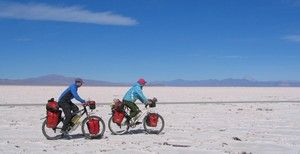 Salinas Grandes I: The Salinas
Grandes are a gigantic dry salt lake on a height of 3400 m. So far
the eye passes only brilliant white who is so garish that we carry
for a long time once again sunglasses and put cream on thickly with
sun lotion to protect ourselves from the strong UV-Strahlug. An anyhow
unreal scenery. Here, actually, we wanted to whip on the Salinas our
tent, however, yesterday because of the sandy storm we have not reached
them, and, nevertheless, today because of scanty stores of water we
still have to go some kilometres farther. Salinas Grandes I: The Salinas
Grandes are a gigantic dry salt lake on a height of 3400 m. So far
the eye passes only brilliant white who is so garish that we carry
for a long time once again sunglasses and put cream on thickly with
sun lotion to protect ourselves from the strong UV-Strahlug. An anyhow
unreal scenery. Here, actually, we wanted to whip on the Salinas our
tent, however, yesterday because of the sandy storm we have not reached
them, and, nevertheless, today because of scanty stores of water we
still have to go some kilometres farther. |
| |
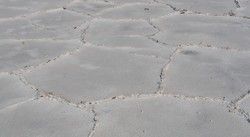 Salinas Grandes II: Although
the Salinas Grandes like a gigantic, absolutely level surface work,
nevertheless, the salt crust has formed nothing but hexagonal fields. Salinas Grandes II: Although
the Salinas Grandes like a gigantic, absolutely level surface work,
nevertheless, the salt crust has formed nothing but hexagonal fields.
|
| |
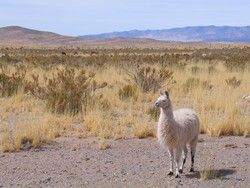 Llamas (Arg.): Here the first
Llamas we get to see at close range. Llamas are the domesticated form
of the llamas. We have already more often seen the wild Guanakos and
Vicuñas though, nevertheless, they mostly remain on flight
distance. Llamas (Arg.): Here the first
Llamas we get to see at close range. Llamas are the domesticated form
of the llamas. We have already more often seen the wild Guanakos and
Vicuñas though, nevertheless, they mostly remain on flight
distance. |
| |
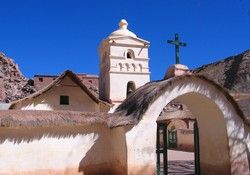 Susques (Arg.): Susques is, actually,
a small small town on the Altiplano that, nevertheless, is rather
active, because here the Argentine customs have established itself
(120 km before the real border remotely).Für to us Susques the
last possibility to us is to be covered before San Pedro de Atacama
with food there should be (water also directly on the border), and
thus we storm the small Supermercados. Nevertheless, in the middle
of the whole customs bustle a wonderful small church which was built
already in 1598 hides in Susques. From the inside affectionately are
painted to us in the special one the built with mortar seat possibilities
along the Längsseiten of the church struck. Not to damage the
nice paintings, nevertheless, one may take photos inside to use no
flash, and to take photos without flash, nevertheless, it is too dark. Susques (Arg.): Susques is, actually,
a small small town on the Altiplano that, nevertheless, is rather
active, because here the Argentine customs have established itself
(120 km before the real border remotely).Für to us Susques the
last possibility to us is to be covered before San Pedro de Atacama
with food there should be (water also directly on the border), and
thus we storm the small Supermercados. Nevertheless, in the middle
of the whole customs bustle a wonderful small church which was built
already in 1598 hides in Susques. From the inside affectionately are
painted to us in the special one the built with mortar seat possibilities
along the Längsseiten of the church struck. Not to damage the
nice paintings, nevertheless, one may take photos inside to use no
flash, and to take photos without flash, nevertheless, it is too dark. |
| |
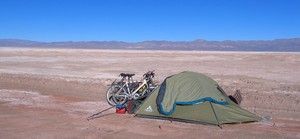 Night frost in the southern tropics:
We have crossed just the southern tropic and are therefore officially
in the tropics. However, from palms, beach and sunshine far and wide
no track. Instead, we receive our first one really strict night frost.
Shortly before sunrise have-11°C in the tent and-18°C before
the tent. In the inside tent we have a kleinwenig hoarfrost of our
frozen breath air. Not to freeze by the icy heights both have laid
in addition to our warm sleeping-bags still a thin summer sleeping-bag
virtually as a kind of cover about us and have connected with a zipper
with the Isomatten. The system functions so very well that to us both
becomes too hot at night and we even start to stimulate the sleeping-bags.
Actually, we have another 2 hot-water bottles including, however if
it does not become much colder we have purchased them probably free
of charge. Night frost in the southern tropics:
We have crossed just the southern tropic and are therefore officially
in the tropics. However, from palms, beach and sunshine far and wide
no track. Instead, we receive our first one really strict night frost.
Shortly before sunrise have-11°C in the tent and-18°C before
the tent. In the inside tent we have a kleinwenig hoarfrost of our
frozen breath air. Not to freeze by the icy heights both have laid
in addition to our warm sleeping-bags still a thin summer sleeping-bag
virtually as a kind of cover about us and have connected with a zipper
with the Isomatten. The system functions so very well that to us both
becomes too hot at night and we even start to stimulate the sleeping-bags.
Actually, we have another 2 hot-water bottles including, however if
it does not become much colder we have purchased them probably free
of charge. |
| |
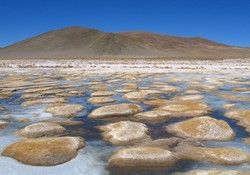 Great plateaus: The plateaus
up here in Argentina are wonderful, in particular if the surfaces
exist of ice and salt. Great plateaus: The plateaus
up here in Argentina are wonderful, in particular if the surfaces
exist of ice and salt. |
| |
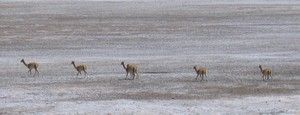 Vicuñas (Arg.): Vicuñas
on a salt lake. Vicuñas live on the Altiplano by heights more
than 4000 m. The fine golden wool of the Vicuñas was the exclusive
property the Inca kings, and thus the elegant animals were the Spaniard
by the Incas strictly protected with the arrival were reduced the
population of the animals, nevertheless, from about 2 millions on
presumably gerademal 10000, so that they were threatened almost before
the extinction. However, by protective programmes the inventories
have recovered meanwhile again something. Vicuñas (Arg.): Vicuñas
on a salt lake. Vicuñas live on the Altiplano by heights more
than 4000 m. The fine golden wool of the Vicuñas was the exclusive
property the Inca kings, and thus the elegant animals were the Spaniard
by the Incas strictly protected with the arrival were reduced the
population of the animals, nevertheless, from about 2 millions on
presumably gerademal 10000, so that they were threatened almost before
the extinction. However, by protective programmes the inventories
have recovered meanwhile again something. |
| |
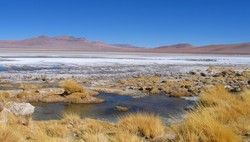 Paso der Jama (Arg. und Chile): In
the Spanish the word paso is used not only for passes but also for
border crossings. Thus it comes that we several height specifications
for the Paso de Jama have: for the Argentine frontier station, for
the real border and for the highest elevation with the pass. Here
at last we have to go more than 4400 m over here. Now, actually, we
are pleased about a nice 157-km-long departure to San Pedro de Atacama,
however, in the frontier station we have discovered a tip, that lets
suppose it not yet that will become completely so easy. Paso der Jama (Arg. und Chile): In
the Spanish the word paso is used not only for passes but also for
border crossings. Thus it comes that we several height specifications
for the Paso de Jama have: for the Argentine frontier station, for
the real border and for the highest elevation with the pass. Here
at last we have to go more than 4400 m over here. Now, actually, we
are pleased about a nice 157-km-long departure to San Pedro de Atacama,
however, in the frontier station we have discovered a tip, that lets
suppose it not yet that will become completely so easy. |
| |
| Route Chile: Paso de Jama, San Pedro
de Atacama |
| |
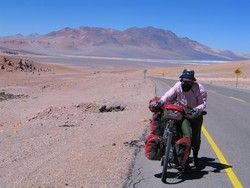 The wind, the wind, the heavenly
child (Chile): Who believes that the big height, the big distances
were our main problems without water and places or even the strict
night frost, unfortunately, that has been mistaken. We deal it up
here because with a taut headwind. And with tightly I mean really
tightly. To us he comes at least as badly before us the wind in Patagonia.
The wind is so strong that we must come out in the level hardly more
than 6 km/h and thrash about partly violently on the departures to
reach 8 - 10 km/h. Although the street is asphalted we are mostly
glad if we in the evening 45 km have cycled. There comes that it is
very warm with from 6°C to 8°C not exactly (has to go according
to guide 20°C) and by the Windchilleffekt it looks damn cold.
We go with thick things, winter gloves, cap and Buff over the mouth
(so that wind and the sun to us do not break the lips totally). Without
wind we could enjoy the marvellous scenery even more, however, thus
one mostly says: Head under it and purely in the storm. The wind, the wind, the heavenly
child (Chile): Who believes that the big height, the big distances
were our main problems without water and places or even the strict
night frost, unfortunately, that has been mistaken. We deal it up
here because with a taut headwind. And with tightly I mean really
tightly. To us he comes at least as badly before us the wind in Patagonia.
The wind is so strong that we must come out in the level hardly more
than 6 km/h and thrash about partly violently on the departures to
reach 8 - 10 km/h. Although the street is asphalted we are mostly
glad if we in the evening 45 km have cycled. There comes that it is
very warm with from 6°C to 8°C not exactly (has to go according
to guide 20°C) and by the Windchilleffekt it looks damn cold.
We go with thick things, winter gloves, cap and Buff over the mouth
(so that wind and the sun to us do not break the lips totally). Without
wind we could enjoy the marvellous scenery even more, however, thus
one mostly says: Head under it and purely in the storm. |
| |
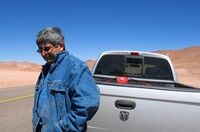 Short lift (Chile): It goes uphill
and the headwind robs us of our last forces once again. After 20 km
we have made completely exhausted already the first break. Since the
break we have created just 5 km and are to be pushed just, besides,
uphill, because we do not arrive against the strong wind any more.
About 500 m before us it looks in such a way, as if the street makes
a strong crease on the left and then we would receive, finally, at
least wind from at an angle behind. We often enough had this hope,
however, mostly the wind has turned with our direction of the traffic
also his direction, so that we seriously do not expect an amendment
also this time . We are to be dreamt in thoughts just, besides, at
least of calm as unexpected a pickup truck beside ourselves a little
piece stops and asks whether he us can pick up. Made easier we accept
and load our bikes, only to find out later 500 m that we had received
now really tail wind!!! Now in total we let ourselves pick up 5 km
to high on a pass where we the a little bit taken aback Chileans ask
ourselves again to stop; because we on the loading area sit we simply
knock on the roof. Three nice Chileans can hardly understand that
we do not want to be puck up with the storm to San Pedro de Atacama. Short lift (Chile): It goes uphill
and the headwind robs us of our last forces once again. After 20 km
we have made completely exhausted already the first break. Since the
break we have created just 5 km and are to be pushed just, besides,
uphill, because we do not arrive against the strong wind any more.
About 500 m before us it looks in such a way, as if the street makes
a strong crease on the left and then we would receive, finally, at
least wind from at an angle behind. We often enough had this hope,
however, mostly the wind has turned with our direction of the traffic
also his direction, so that we seriously do not expect an amendment
also this time . We are to be dreamt in thoughts just, besides, at
least of calm as unexpected a pickup truck beside ourselves a little
piece stops and asks whether he us can pick up. Made easier we accept
and load our bikes, only to find out later 500 m that we had received
now really tail wind!!! Now in total we let ourselves pick up 5 km
to high on a pass where we the a little bit taken aback Chileans ask
ourselves again to stop; because we on the loading area sit we simply
knock on the roof. Three nice Chileans can hardly understand that
we do not want to be puck up with the storm to San Pedro de Atacama.
|
| |
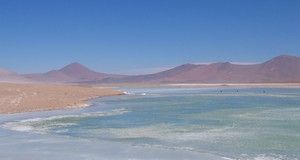 Wonderful mountain world (Chile):
We like the Andes up here in Chile with her many volcanoes, salt
lake, lagoons, moor-like sceneries, Vicuñas and flamingos incredibly
well. If we did not have scarcely limited waters and stocks of food
we would stay here absolutely a little bit longer. Wonderful mountain world (Chile):
We like the Andes up here in Chile with her many volcanoes, salt
lake, lagoons, moor-like sceneries, Vicuñas and flamingos incredibly
well. If we did not have scarcely limited waters and stocks of food
we would stay here absolutely a little bit longer. |
| |
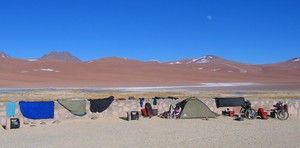 Frozen! (Chile): Once again we
have one night with strict frost (absolutely-18°C) and when we
in the morning already before sunrise wake we have a thick ripe shift
everywhere in the inside tent. As soon as one of us the tent walls
catches touched in in the tent to be snowing and one is full all over
with white frost. Some white frost has already trickled on our Überschlafsack
and has melted partially and has frozen partially then again. Now
good council is expensive. If we wait to the sun comes out and the
white frost melts it catches in in the tent to rain and everything
is soaking wet. So I jump in laxly still-18°C in the sleeping
suit shortly before sunrise out of the tent and spread out our whole
equipment on the wall which is, fortunately, directly behind us. Thus
we strip little piece-wise of the complete tent and spread out everything
to the dry one. As the tent blank is Nadine brushes the whole white
frost on the ground and turns him afterwards out. Until we, finally,
everything repacked dryly, and had breakfast have though it lasts
a little longer than commonly, however, 10:30 o'clock we are again
on the street, today, nevertheless, it should go about the last and
highest pass. Frozen! (Chile): Once again we
have one night with strict frost (absolutely-18°C) and when we
in the morning already before sunrise wake we have a thick ripe shift
everywhere in the inside tent. As soon as one of us the tent walls
catches touched in in the tent to be snowing and one is full all over
with white frost. Some white frost has already trickled on our Überschlafsack
and has melted partially and has frozen partially then again. Now
good council is expensive. If we wait to the sun comes out and the
white frost melts it catches in in the tent to rain and everything
is soaking wet. So I jump in laxly still-18°C in the sleeping
suit shortly before sunrise out of the tent and spread out our whole
equipment on the wall which is, fortunately, directly behind us. Thus
we strip little piece-wise of the complete tent and spread out everything
to the dry one. As the tent blank is Nadine brushes the whole white
frost on the ground and turns him afterwards out. Until we, finally,
everything repacked dryly, and had breakfast have though it lasts
a little longer than commonly, however, 10:30 o'clock we are again
on the street, today, nevertheless, it should go about the last and
highest pass. |
| |
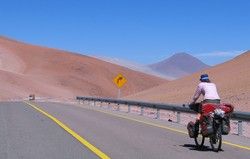 passes, passes, passes (Chile):
Because the route is named over the Andes as a Paso de Jama, we have
assumed, actually, from the fact that this pass stated with 4200 m
is the highest one of the whole distance. However, already in Argentina
we might master another of 3 wide passes, in each case more than 4000
m. Then in Chile it became wilder one more number, because there it
goes immediately twice more than 4800 m and once more than 4700 m! passes, passes, passes (Chile):
Because the route is named over the Andes as a Paso de Jama, we have
assumed, actually, from the fact that this pass stated with 4200 m
is the highest one of the whole distance. However, already in Argentina
we might master another of 3 wide passes, in each case more than 4000
m. Then in Chile it became wilder one more number, because there it
goes immediately twice more than 4800 m and once more than 4700 m! |
| |
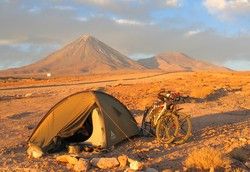 Long descent Chile): Then, however,
on the last 50 km it goes from 4800 m in a gigantic long departure
under it up to 2436 m. On the way we stop sometimes, so that our rims
can cool off again, because we breake them quite hot. Nevertheless,
in principle we want to arrive only the next morning in San Pedro
de Atacama and thus we whip in the middle on the departure over again
our tent and enjoy the marvellous view of the volcano Licancabur lying
behind us (5916m) and the Atacama lying among us desert. Long descent Chile): Then, however,
on the last 50 km it goes from 4800 m in a gigantic long departure
under it up to 2436 m. On the way we stop sometimes, so that our rims
can cool off again, because we breake them quite hot. Nevertheless,
in principle we want to arrive only the next morning in San Pedro
de Atacama and thus we whip in the middle on the departure over again
our tent and enjoy the marvellous view of the volcano Licancabur lying
behind us (5916m) and the Atacama lying among us desert. |
| |
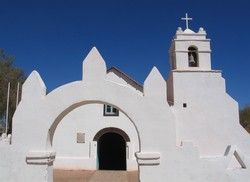 San Pedro de Atacama (Chile):
San Pedro de Atacama, once an idyllic oasis, has moulted meanwhile
to the tourist stronghold in the north of Chile. When we in the place
walk in we are inspired by the quiet comfortable village with his
picturesque marketplace and the nice church and can hardly understand
why it should be so tourist here. Nevertheless, this changes all of
a sudden when in the afternoon all tourists return from her tours
of the surrounding places of interest in the Atacama desert. Suddenly
there rules everywhere an active activity and we withdraw into our
Hostel where we meet on very nice tourists from London, California,
Sydney and Santiago de Chile and half a night in blether are. San Pedro de Atacama (Chile):
San Pedro de Atacama, once an idyllic oasis, has moulted meanwhile
to the tourist stronghold in the north of Chile. When we in the place
walk in we are inspired by the quiet comfortable village with his
picturesque marketplace and the nice church and can hardly understand
why it should be so tourist here. Nevertheless, this changes all of
a sudden when in the afternoon all tourists return from her tours
of the surrounding places of interest in the Atacama desert. Suddenly
there rules everywhere an active activity and we withdraw into our
Hostel where we meet on very nice tourists from London, California,
Sydney and Santiago de Chile and half a night in blether are. |
| |
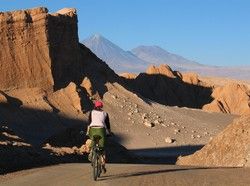 Valle de la Luna (Chile): Eine
der One of the main tourist attractions of San Pedro de Atacama is
the so-called Valle de la Luna, the valley of the moon. The Valle
de la Luna owes his name to the wind and the rain which have created
here an amusing lunar landscape. The Valle de la Luna at sundown is
especially impressive, however, to explore it in complete silence
one needs absolutely some hours. Valle de la Luna (Chile): Eine
der One of the main tourist attractions of San Pedro de Atacama is
the so-called Valle de la Luna, the valley of the moon. The Valle
de la Luna owes his name to the wind and the rain which have created
here an amusing lunar landscape. The Valle de la Luna at sundown is
especially impressive, however, to explore it in complete silence
one needs absolutely some hours. |
| |
|
Route Chile: Calama, Ollagüe
|
| |
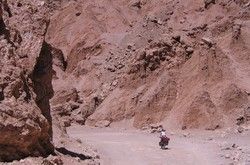 Valle de la Muerte (Chile): The
"valley of the death" directly before the gates of San Pedro
de Atacama. Valle de la Muerte (Chile): The
"valley of the death" directly before the gates of San Pedro
de Atacama. |
| |
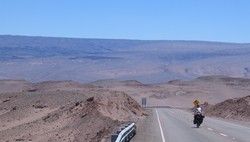 Easily downhill to Calama (Chile):
From San Pedro we further want in 100 km lain cal ama. Because the
Touristeninfoirmation is concluded the last both days we enquire in
the travel agency, the tours to the surrounding places of interest
organised after the street." It goes constantly only downhill"
we agree as an answer to the question whether the distance would be
very mountainous. From the answer completely persuaded I do not stick
over again after while I to the young man explains that on the map
lying before him, however, some height lines were marked what would
probably point to mountains. Now he asks his colleague over again,
and together they assure us that it went though at the beginning small
a little uphill, however, then constantly downhill. This would be
evident, because cal ama would lie 200 metre height deeper. We remain
sceptical and fill in for safety's sake rather all our water bottles,
because we are, at least, in the Atacama desert. Then directly behind
San Pedro it goes already immediately uphill and 200 metres height
we could master one well and with pleasure as the "small increase"
evaluate. Nevertheless, unfortunately it goes on the other side directly
again down in the valley only around then really high of going to
the mountains. For the "small increase following now" we
need the rest of the day, and at sundown we find ourselves after 40
cycled kilometres and 1150 m of increase on a pass situated on about
3300 m. But then the next day it goes really only downhill to cal
ama. Easily downhill to Calama (Chile):
From San Pedro we further want in 100 km lain cal ama. Because the
Touristeninfoirmation is concluded the last both days we enquire in
the travel agency, the tours to the surrounding places of interest
organised after the street." It goes constantly only downhill"
we agree as an answer to the question whether the distance would be
very mountainous. From the answer completely persuaded I do not stick
over again after while I to the young man explains that on the map
lying before him, however, some height lines were marked what would
probably point to mountains. Now he asks his colleague over again,
and together they assure us that it went though at the beginning small
a little uphill, however, then constantly downhill. This would be
evident, because cal ama would lie 200 metre height deeper. We remain
sceptical and fill in for safety's sake rather all our water bottles,
because we are, at least, in the Atacama desert. Then directly behind
San Pedro it goes already immediately uphill and 200 metres height
we could master one well and with pleasure as the "small increase"
evaluate. Nevertheless, unfortunately it goes on the other side directly
again down in the valley only around then really high of going to
the mountains. For the "small increase following now" we
need the rest of the day, and at sundown we find ourselves after 40
cycled kilometres and 1150 m of increase on a pass situated on about
3300 m. But then the next day it goes really only downhill to cal
ama. |
| |
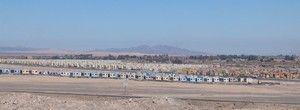 Calama (Chile): Calama is a modern
town as a service centre for the surrounding mines serves. Apparently
live and work here also a lot of foreigners, because the Shoppingmall
(2-storied with cinema) is the most modern one we up to now in South
America have seen and what resembles rather Nadine with her sister
in the USA has seen. Although we here only the afternoon spend around
post to send, to exchange money and food for them go on to Bolivia
to make purchases the clean town likes us very well. In particular
many outgoing, helpful and hearty inhabitants of cal ama will still
remain to us long in recollection Calama (Chile): Calama is a modern
town as a service centre for the surrounding mines serves. Apparently
live and work here also a lot of foreigners, because the Shoppingmall
(2-storied with cinema) is the most modern one we up to now in South
America have seen and what resembles rather Nadine with her sister
in the USA has seen. Although we here only the afternoon spend around
post to send, to exchange money and food for them go on to Bolivia
to make purchases the clean town likes us very well. In particular
many outgoing, helpful and hearty inhabitants of cal ama will still
remain to us long in recollection |
| |
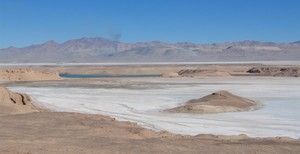 Copper mine (Chile): Before the
gates of cal ama lies Chuquicamata, the biggest open copper mine of
the world. The gigantic pit is 4 km long, 2 km wide and 730 m deep
(2005). Suitably to these gigantic dimensions the 3.5-m-high wheels
of the Lkws are the 310-t-piles transport. 8000 workers produces so
yearly 600000 t of copper. The mine is the world-biggest supplier
of copper and gained in 2003 17% of the whole Chilean Exporteinkomens!
The copper mine is there where one the cloud of smoke can recognise. Copper mine (Chile): Before the
gates of cal ama lies Chuquicamata, the biggest open copper mine of
the world. The gigantic pit is 4 km long, 2 km wide and 730 m deep
(2005). Suitably to these gigantic dimensions the 3.5-m-high wheels
of the Lkws are the 310-t-piles transport. 8000 workers produces so
yearly 600000 t of copper. The mine is the world-biggest supplier
of copper and gained in 2003 17% of the whole Chilean Exporteinkomens!
The copper mine is there where one the cloud of smoke can recognise. |
| |
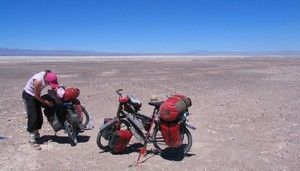 Atacama desert (Chile): The Atacama
desert is one of the driest places of the world and at some places
rain was never still registered. On the way from cal ama we meet all
at once quite many travellers who are in the middle on the way in
the desert to a Christian festival to honour of the virgin of Ayquina. Atacama desert (Chile): The Atacama
desert is one of the driest places of the world and at some places
rain was never still registered. On the way from cal ama we meet all
at once quite many travellers who are in the middle on the way in
the desert to a Christian festival to honour of the virgin of Ayquina.
|
| |
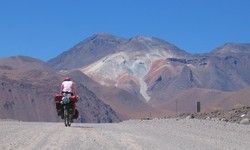 Volcano scenery (Chile): By the
Atacamawüste and past wonderful volcanoes the beginning still
screws to themselves tarred street of Clama further high in the Andes
to Bolivia. Volcano scenery (Chile): By the
Atacamawüste and past wonderful volcanoes the beginning still
screws to themselves tarred street of Clama further high in the Andes
to Bolivia. |
| |
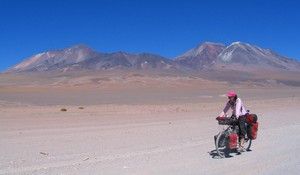 Railway line to Bolivia (Chile):
The distance to Bolivia runs more or less in parallel with a railway
line Chile and Bolivia connects. The railway line has built Chile
as a reparation on Bolivia for in the Pazifikrieg in 19. Jhr to taken
areas in the Atacamawüste. At that time thus Bolivia has lost
not only his access to the Pacific, but also all mines which justify
today the wealth of Chile. Railway line to Bolivia (Chile):
The distance to Bolivia runs more or less in parallel with a railway
line Chile and Bolivia connects. The railway line has built Chile
as a reparation on Bolivia for in the Pazifikrieg in 19. Jhr to taken
areas in the Atacamawüste. At that time thus Bolivia has lost
not only his access to the Pacific, but also all mines which justify
today the wealth of Chile. |
| |
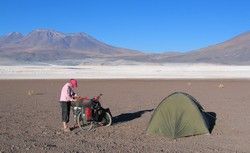 Salar de Ascotan (Chile): After
we wanted to have reached the highest point on the way to Bolivia
we with the gendarmerie again our stores of water with only 3966 m
fill in. Because the drinking water should be here, nevertheless,
an arsenic-contaminated we get as a gift from the nice gendarmes 2
bottles of mineral water. Now it goes down on the big Salar de Ascotan
on which still some salts (according to Jorge Borax) are diminished.
We ralden partially in the middle, or by the Salar, however, thus
long we, nevertheless, exactly do not know it to ourselves by around
what the stuff acts we try to avoid every direct contact. Nice is
to be looked of the Salar, however, always. Salar de Ascotan (Chile): After
we wanted to have reached the highest point on the way to Bolivia
we with the gendarmerie again our stores of water with only 3966 m
fill in. Because the drinking water should be here, nevertheless,
an arsenic-contaminated we get as a gift from the nice gendarmes 2
bottles of mineral water. Now it goes down on the big Salar de Ascotan
on which still some salts (according to Jorge Borax) are diminished.
We ralden partially in the middle, or by the Salar, however, thus
long we, nevertheless, exactly do not know it to ourselves by around
what the stuff acts we try to avoid every direct contact. Nice is
to be looked of the Salar, however, always. |
| |
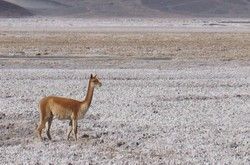 More Vicuñas (Chile): Now
up here on the Salares we see, actually, constantly Vicuñas
which prosper to itself apparently from the scanty plants (presumably
mosses and lichens) here on the salt lakes nourish. Mostly the Vicuñas
have no fear of us and observe only curiously the funny people with
so strange things (bicycles) move. The people ordinarily have, nevertheless,
jeeps, coaches or Lkws! More Vicuñas (Chile): Now
up here on the Salares we see, actually, constantly Vicuñas
which prosper to itself apparently from the scanty plants (presumably
mosses and lichens) here on the salt lakes nourish. Mostly the Vicuñas
have no fear of us and observe only curiously the funny people with
so strange things (bicycles) move. The people ordinarily have, nevertheless,
jeeps, coaches or Lkws! |
| |
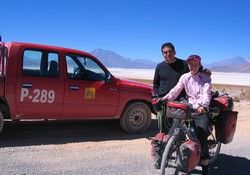 Jorge (Chile): Up here immediately
twice we meet Jorge who works for the railway company and is on the
move up here with his pickup truck. Though one has offered quite other
places to him, however , he likes the wonderful area with her many
Vicuñas and flamingos up here so well that he wants here not
away. When we him erstemal hit he spends to us a round coke and supplies
us with a lot of helpful distance information. The next day we meet
him again to a small chat and this time he immediately hands to us
a whole coke bottle, while he reports to us completely enthusiastically
that he has seen just a fox. Jorge (Chile): Up here immediately
twice we meet Jorge who works for the railway company and is on the
move up here with his pickup truck. Though one has offered quite other
places to him, however , he likes the wonderful area with her many
Vicuñas and flamingos up here so well that he wants here not
away. When we him erstemal hit he spends to us a round coke and supplies
us with a lot of helpful distance information. The next day we meet
him again to a small chat and this time he immediately hands to us
a whole coke bottle, while he reports to us completely enthusiastically
that he has seen just a fox. |
| |
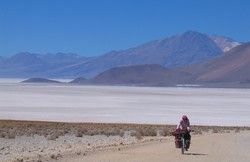 Ollagüe (Chile): Our last
place in Chile is called Ollagüe and is the small border place
and railway station up here in the middle of the scanty high mountain
desert on 3690 m. Here the people are incredibly kind, friendly and
in a good mood and thus we spend with joy our last Chilean peso before
we further to Bolivia cycle. Ollagüe (Chile): Our last
place in Chile is called Ollagüe and is the small border place
and railway station up here in the middle of the scanty high mountain
desert on 3690 m. Here the people are incredibly kind, friendly and
in a good mood and thus we spend with joy our last Chilean peso before
we further to Bolivia cycle. |
| |
| Route Bolivia: San Juan, Concha K, Salar
Uyuni, Tambo Tambillo, Quillacas, Challapata, Oruro |
| |
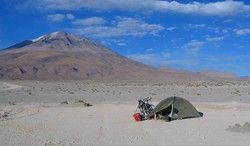 Welcome to Bolivia: Nevertheless,
immediately with the entry formalities the first disillusionment,
the border official requires all at once 15 Bolivianos (about 1.50€)
of us for the entry stamp. Ordinarily one must pay the money, nevertheless,
only with the crossing the border, however, with foreign tourists
one can make quietly sometimes an exception. Because we had not succeeded
in Chile, nevertheless Bolivianos (BS) in acquiring to a more or less
satisfactory exchange rate (the Chileans have offered the exchange
to 30% under exchange rate value to us!!!) we have of course no 15
BS per nose. Then, nevertheless, alternatively the border official
accepts also "generous-wise" US $, however, now we must
pay per nose 3 US $ (instead of ordinarily 2 US $). Long live the
corruption!!!! Welcome to Bolivia: Nevertheless,
immediately with the entry formalities the first disillusionment,
the border official requires all at once 15 Bolivianos (about 1.50€)
of us for the entry stamp. Ordinarily one must pay the money, nevertheless,
only with the crossing the border, however, with foreign tourists
one can make quietly sometimes an exception. Because we had not succeeded
in Chile, nevertheless Bolivianos (BS) in acquiring to a more or less
satisfactory exchange rate (the Chileans have offered the exchange
to 30% under exchange rate value to us!!!) we have of course no 15
BS per nose. Then, nevertheless, alternatively the border official
accepts also "generous-wise" US $, however, now we must
pay per nose 3 US $ (instead of ordinarily 2 US $). Long live the
corruption!!!! |
| |
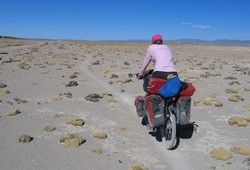 Where to now? According to guide an unmade
street should lead in Bolivia further to the Salar de Uyuni, however,
the streets here makes on us an excellent impression. There are not
other streets here according to map. Nevertheless, something are irritated
we, because the street follows not like according to map of the railway
line, but a little bit more direction the south goes. For safety's
sake we ask over again with the customs whether this is the right
street. Yes, one says, the street goes to Uyuni. We follow the really
good grit runway, however, instead of the expected direction change
to the east it goes constantly further after southwest. After about
15 km we urge an oncoming pickup truck to ask over again for the course
of the street. Now both very nice Bolivians explain to us that this
one new street is though also to the city of Uyuni would lead, however,
would make a small curve and would not lead direction Salar de Uyuni.
If we to the Salar wanted then we would have to cycle a little bit
back and then above a small way in the direction of north cycle around
sometime again on the old way which follows the railway to hit. The
small way is extremely sandy, and thus we cycle and push still 5 km
before we already in get dark our tent hit. On the only sign we see
the inscription has already flaked off up to the unrecognizability
and therefore no real help. The next morning then we cycle down in
the level, however, now the way forks. On the right, the east and,
actually, our direction, nevertheless, the way leads after 1 kilometre
in an old mine, so that we choose the left way (to the west) which
seems to lead, nevertheless, again back to the border. A way to the
north in the direction of railway line would be favourite to us, however,
unfortunately, there is not him. We follow the way to the west for
a while and even as we by a small crisis meeting in decide are whether
we should take, nevertheless, the way by the mine or should go directly
about the Salar to the north, we see in the northern horizon (there
where we want to go) the cloud of dust of a jeep. Tensely we follow
the jeep over and over again behind hills disappears, with our eyes
and after about 15 minutes he goes not far past from us and disappears
after the south. OK. there goes the way long. We follow the rigid
lane, still meet some other tourist jeeps, and, finally, after some
kilometres we reach the railway line. How are back on the right way!!!
However, of it that the lane (Away or even street would be an exaggeration)
in parallel with the railway runs the speech cannot be. We see time
to be the railway route just still thus in the horizon only around
shortly after again directly beside her. With a military camp the
lanes lead all at once about the Salar de Chuguana to the north instead
of like according to map to the east, however, we follow for safety's
sake sometimes the lanes, because we come having from there some tourist
jeeps see. Confusion arises again when we head for San Juan, the next
place which should lie according to map directly with the railway
line, however, the only houses we see lie about 10 km away of it in
the mountains. We trust the lanes and to our astonishment the place
is in the hills really San Juan. We must push the letzen kilometres,
nevertheless, by deep sand. From here it further goes after Concha
K, a little bigger place which would have to lie in scanty 18 km according
to travelog of a Swiss cyclist. We follow a corrugated sheet runway
bad here and there and sandy runway and after 12 km a sign "Concha
K comes all at once to the left". Unfortunately three ways go
here, nevertheless, to the left, and thus good council is once again
expensive. We have luck and after some minutes again there comes a
tourist jeep which brings us on the right one of three ways. The lanes
lead again by open scenery with some putting on one side, nevertheless,
at last we reach safely after 30 km of Concha K. Anscheinend here
the Swiss cyclist whose information is otherwise distinguished had
found any abbreviation. Where to now? According to guide an unmade
street should lead in Bolivia further to the Salar de Uyuni, however,
the streets here makes on us an excellent impression. There are not
other streets here according to map. Nevertheless, something are irritated
we, because the street follows not like according to map of the railway
line, but a little bit more direction the south goes. For safety's
sake we ask over again with the customs whether this is the right
street. Yes, one says, the street goes to Uyuni. We follow the really
good grit runway, however, instead of the expected direction change
to the east it goes constantly further after southwest. After about
15 km we urge an oncoming pickup truck to ask over again for the course
of the street. Now both very nice Bolivians explain to us that this
one new street is though also to the city of Uyuni would lead, however,
would make a small curve and would not lead direction Salar de Uyuni.
If we to the Salar wanted then we would have to cycle a little bit
back and then above a small way in the direction of north cycle around
sometime again on the old way which follows the railway to hit. The
small way is extremely sandy, and thus we cycle and push still 5 km
before we already in get dark our tent hit. On the only sign we see
the inscription has already flaked off up to the unrecognizability
and therefore no real help. The next morning then we cycle down in
the level, however, now the way forks. On the right, the east and,
actually, our direction, nevertheless, the way leads after 1 kilometre
in an old mine, so that we choose the left way (to the west) which
seems to lead, nevertheless, again back to the border. A way to the
north in the direction of railway line would be favourite to us, however,
unfortunately, there is not him. We follow the way to the west for
a while and even as we by a small crisis meeting in decide are whether
we should take, nevertheless, the way by the mine or should go directly
about the Salar to the north, we see in the northern horizon (there
where we want to go) the cloud of dust of a jeep. Tensely we follow
the jeep over and over again behind hills disappears, with our eyes
and after about 15 minutes he goes not far past from us and disappears
after the south. OK. there goes the way long. We follow the rigid
lane, still meet some other tourist jeeps, and, finally, after some
kilometres we reach the railway line. How are back on the right way!!!
However, of it that the lane (Away or even street would be an exaggeration)
in parallel with the railway runs the speech cannot be. We see time
to be the railway route just still thus in the horizon only around
shortly after again directly beside her. With a military camp the
lanes lead all at once about the Salar de Chuguana to the north instead
of like according to map to the east, however, we follow for safety's
sake sometimes the lanes, because we come having from there some tourist
jeeps see. Confusion arises again when we head for San Juan, the next
place which should lie according to map directly with the railway
line, however, the only houses we see lie about 10 km away of it in
the mountains. We trust the lanes and to our astonishment the place
is in the hills really San Juan. We must push the letzen kilometres,
nevertheless, by deep sand. From here it further goes after Concha
K, a little bigger place which would have to lie in scanty 18 km according
to travelog of a Swiss cyclist. We follow a corrugated sheet runway
bad here and there and sandy runway and after 12 km a sign "Concha
K comes all at once to the left". Unfortunately three ways go
here, nevertheless, to the left, and thus good council is once again
expensive. We have luck and after some minutes again there comes a
tourist jeep which brings us on the right one of three ways. The lanes
lead again by open scenery with some putting on one side, nevertheless,
at last we reach safely after 30 km of Concha K. Anscheinend here
the Swiss cyclist whose information is otherwise distinguished had
found any abbreviation. |
| |
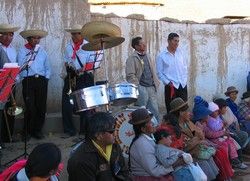 Festival in Concha K: Although is marked
in our map as a provincial centre Concha K a small place in which
there are, nevertheless, some shops which use to us in the absence
of Bolivianos, nevertheless, anyhow nothing. Nevertheless, in the
village just a religious festival town finds and thus are all inhabitants
on the legs. Something behind the marketplace is the real fairground
on itself everything has gathered around to the music of a brass band
to dance. The party already seems to be some hours going, because
nearly all adult, men like women, are completely got drunk. Many are
so got drunk even that it is a miracle that they can keep generally
still on the legs, or can still dance. We do not want to disturb the
playful mood of the party further (anyhow we feel to us is absent
on the place) and there it already shortly before sundown is we still
fill in fast our water bottles and cycle a few more kilometres farther. Festival in Concha K: Although is marked
in our map as a provincial centre Concha K a small place in which
there are, nevertheless, some shops which use to us in the absence
of Bolivianos, nevertheless, anyhow nothing. Nevertheless, in the
village just a religious festival town finds and thus are all inhabitants
on the legs. Something behind the marketplace is the real fairground
on itself everything has gathered around to the music of a brass band
to dance. The party already seems to be some hours going, because
nearly all adult, men like women, are completely got drunk. Many are
so got drunk even that it is a miracle that they can keep generally
still on the legs, or can still dance. We do not want to disturb the
playful mood of the party further (anyhow we feel to us is absent
on the place) and there it already shortly before sundown is we still
fill in fast our water bottles and cycle a few more kilometres farther. |
| |
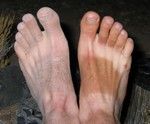 Shows me your feet: Up here the
dusty washing board runways are a really very first cream and as thankfully
as we are to the tourist jeeps for her guidance, thus we are also
irritated by the gigantic clouds of dust them whirl up if them to
us vorbeibrettern. In spite of scanty stores of water we wash every
evening around the thick dust shifts we abzuschrubben. Shows me your feet: Up here the
dusty washing board runways are a really very first cream and as thankfully
as we are to the tourist jeeps for her guidance, thus we are also
irritated by the gigantic clouds of dust them whirl up if them to
us vorbeibrettern. In spite of scanty stores of water we wash every
evening around the thick dust shifts we abzuschrubben. |
| |
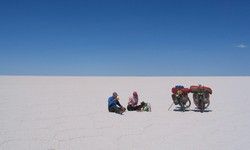 Salar Uyuni: The next day, finally, then
it goes on the Salar de Uyuni, the biggest and highest salt lake of
the earth on 3653 m. After many washing board runways and sandy runways
of the last days cycling on the smooth and firm salt crust is a true
relief. Actually, we were dealted with a little bit because of the
orientation on the Salar, however, thanks to the road description
of the Swiss and the black lanes not to be overlooked (thanks to tyre
wear) of the tourist jeeps the orientation is absolutely trouble-free.
About 40 km we go dead-straight northwards up to Isla Inkawasi who
lies here in the middle of the Salar. One can see the island, by the
way, already from 30 km of distance. Salar Uyuni: The next day, finally, then
it goes on the Salar de Uyuni, the biggest and highest salt lake of
the earth on 3653 m. After many washing board runways and sandy runways
of the last days cycling on the smooth and firm salt crust is a true
relief. Actually, we were dealted with a little bit because of the
orientation on the Salar, however, thanks to the road description
of the Swiss and the black lanes not to be overlooked (thanks to tyre
wear) of the tourist jeeps the orientation is absolutely trouble-free.
About 40 km we go dead-straight northwards up to Isla Inkawasi who
lies here in the middle of the Salar. One can see the island, by the
way, already from 30 km of distance. |
| |
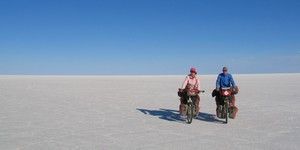 A dream in white! A dream in white! |
| |
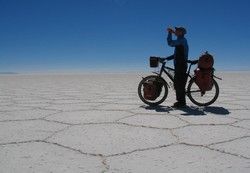 Hexagon-shaped salt edges: To
destroy the nice hexagonal salt edges not needlessly we also keep
quite well to the lanes (except around briefly a few photos to make). Hexagon-shaped salt edges: To
destroy the nice hexagonal salt edges not needlessly we also keep
quite well to the lanes (except around briefly a few photos to make).
|
| |
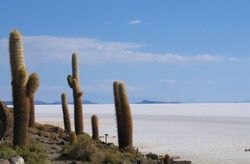 Isla Inkawasi: Though Isla Inkawasi is
not the only island on the Salar, however she lies where to herself
the main routes on the Salar cruise and, besides, still about a restaurant
disposes, it is the approach point for all tourist jeeps. The island
itself is covered with many old cacti (should be 1200 years old to).
Because the whole scenery lay here once under the sea covertly, there
are on the island still many corals what looks a little bit droll
up here on the Altiplano of course. We fill in our stores of water
with the restaurant again and then disappear on the quieter south
side of the islands around a few photo admissions to make. Here, actually,
we also want to whip our tent, because we can enjoy thus sundown as
well as from sunrise, however, suddenly a storm-like west wind starts,
so that we must proceed in the windbreak of the island and can make
to no nice sundown photos. Isla Inkawasi: Though Isla Inkawasi is
not the only island on the Salar, however she lies where to herself
the main routes on the Salar cruise and, besides, still about a restaurant
disposes, it is the approach point for all tourist jeeps. The island
itself is covered with many old cacti (should be 1200 years old to).
Because the whole scenery lay here once under the sea covertly, there
are on the island still many corals what looks a little bit droll
up here on the Altiplano of course. We fill in our stores of water
with the restaurant again and then disappear on the quieter south
side of the islands around a few photo admissions to make. Here, actually,
we also want to whip our tent, because we can enjoy thus sundown as
well as from sunrise, however, suddenly a storm-like west wind starts,
so that we must proceed in the windbreak of the island and can make
to no nice sundown photos. |
| |
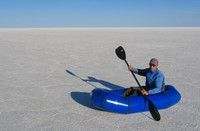 Paddeling: Once in the life on a salt lake paddle
I imagined and make our Packrafts ready to be launched. Nevertheless,
unfortunately, I do not come anyhow so properly from the spot. This
is a nice lake if one can not even paddle on him. :-))) Paddeling: Once in the life on a salt lake paddle
I imagined and make our Packrafts ready to be launched. Nevertheless,
unfortunately, I do not come anyhow so properly from the spot. This
is a nice lake if one can not even paddle on him. :-))) |
| |
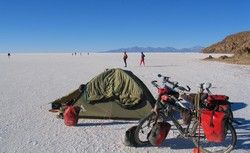 Marathon team: After we spend in the lee
of the island and when we the next morning with sunrise from the tent
have an eye we do not look badly when all at once a whole team of
joggers goes past!!! The team exists of 21 predominantly American
marathon runners who take a "run vacation" here in South
America. At the latest every 2nd day is run, and is denied every now
and then also a marathon (one is in a few days in the brine Titicaca).Für
today are attached on the Salar 21 km, before it further goes to Potosi.
Most runners are not acclimatised yet completely so optimally, finally,
we are on 3650 m, and thus they allow to concern it relatively quietly.
In the team is also a German marathon runner who has denied a marathon
on the North Pole in spite of his old age (nearly 70) only few weeks
ago. Marathon team: After we spend in the lee
of the island and when we the next morning with sunrise from the tent
have an eye we do not look badly when all at once a whole team of
joggers goes past!!! The team exists of 21 predominantly American
marathon runners who take a "run vacation" here in South
America. At the latest every 2nd day is run, and is denied every now
and then also a marathon (one is in a few days in the brine Titicaca).Für
today are attached on the Salar 21 km, before it further goes to Potosi.
Most runners are not acclimatised yet completely so optimally, finally,
we are on 3650 m, and thus they allow to concern it relatively quietly.
In the team is also a German marathon runner who has denied a marathon
on the North Pole in spite of his old age (nearly 70) only few weeks
ago. |
| |
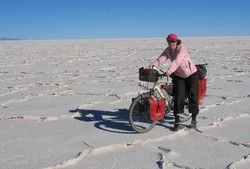 Salar Uyuni to push: According
to our map it looks thus as if it was to be driven substantially shorter
by Isla Inkawasi to north-east directly to Tacarani than about the
Salinas Garcia in the north. Without further ado we resolve to try
our luck. First everything still runs rather well and thus we come
to the east of the volcano Tunapa to a nice small place before a gigantic
herd Llamas puts out to pasture and with on a small lagoon bulky flamingos
are to be admired. I ask a Llamahirtin which direction we should smash
best of all around about the Salar to Tacarani to come, however, unfortunately,
woman has no notion whether and what for places are on the other side
of the Salar. Thus we drive off roughly after feeling, because our
compass has a gigantic air bubble and is also not particularly helpful.
Because none of the lanes in the direction aimed by us leads we simply
cycle "quersalzein". The salt is nicely firm and crunches
as really coldly frozen snow. Nevertheless, after a while the salt
becomes more humid, we sink even something, and everywhere from the
tyres it splashes there. We change our direction a little bit southwards
and come so luckily again to more firm regions. Nevertheless, after
some kilometres the surface of the Salar changes once more and instead
of the nice smooth roadway with the hexagonal fields now it is very
rough and hubbelig. Our speed decreases from comfortable 18 km/h on
strenuous 10 km/h. After a while the salt becomes more humid and softer
again, and we become even slower. At last it goes off in such a way
that we must descend and push. Suddenly the salt changes suddenly
and we deal it with soft quite fine loose mud. Our heavy bicycles
deeply sink and thus we struggle laboriously pushing forward. In total
we push our wheels 7 km, before we reach firm reason shortly before
sundown again. To our joy we can see a few kilometres farther a small
village. Tacarani, as we hope. We cycle and push on sandy runways
in de small place where we shortly after sundown arrive. As we are
found out now we though not in Tacarani landed, but in a little village
with 3 families about 10 km farther to the north, however because
we anyhow want further to the north only suits us. Nevertheless, at
last from 50 km easy according to map of stage (abbreviation) quite
strenuous 80 km of day has become. Salar Uyuni to push: According
to our map it looks thus as if it was to be driven substantially shorter
by Isla Inkawasi to north-east directly to Tacarani than about the
Salinas Garcia in the north. Without further ado we resolve to try
our luck. First everything still runs rather well and thus we come
to the east of the volcano Tunapa to a nice small place before a gigantic
herd Llamas puts out to pasture and with on a small lagoon bulky flamingos
are to be admired. I ask a Llamahirtin which direction we should smash
best of all around about the Salar to Tacarani to come, however, unfortunately,
woman has no notion whether and what for places are on the other side
of the Salar. Thus we drive off roughly after feeling, because our
compass has a gigantic air bubble and is also not particularly helpful.
Because none of the lanes in the direction aimed by us leads we simply
cycle "quersalzein". The salt is nicely firm and crunches
as really coldly frozen snow. Nevertheless, after a while the salt
becomes more humid, we sink even something, and everywhere from the
tyres it splashes there. We change our direction a little bit southwards
and come so luckily again to more firm regions. Nevertheless, after
some kilometres the surface of the Salar changes once more and instead
of the nice smooth roadway with the hexagonal fields now it is very
rough and hubbelig. Our speed decreases from comfortable 18 km/h on
strenuous 10 km/h. After a while the salt becomes more humid and softer
again, and we become even slower. At last it goes off in such a way
that we must descend and push. Suddenly the salt changes suddenly
and we deal it with soft quite fine loose mud. Our heavy bicycles
deeply sink and thus we struggle laboriously pushing forward. In total
we push our wheels 7 km, before we reach firm reason shortly before
sundown again. To our joy we can see a few kilometres farther a small
village. Tacarani, as we hope. We cycle and push on sandy runways
in de small place where we shortly after sundown arrive. As we are
found out now we though not in Tacarani landed, but in a little village
with 3 families about 10 km farther to the north, however because
we anyhow want further to the north only suits us. Nevertheless, at
last from 50 km easy according to map of stage (abbreviation) quite
strenuous 80 km of day has become. |
| |
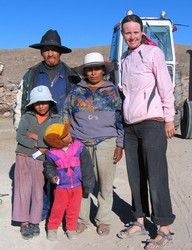 Sonja and Ludgardo part 1: I
believe we look tired after many pushing a little bit and exhausted,
because when we will want to fill in, actually, only water we from
Sonja and her neighbour, an older South American Indian's woman in
the traditional Petticoat and Bowlerhut (melon), directly on a cup
of tea invited. The kitchen of the neighbour is pitch-dark, no window
has and thus some light comes in merely by the Türe. We are allowed
to do ourselves on the bed placed, while the neighbour puts a kettle
to water on the gas range standing on the ground and lights afterwards
a small oil lamp. The oil lamp exists merely of a wick in a tin full
with oil. Presumably we also look half starved, because to the cup
of tea we still receive a piece of fried white bread. After we are
supplied with the most necessary one soy and her neighbour withdraw
and we sit alone in the twilight and strengthen ourselves in the easy
however comfortable kitchen. Actually, we want again from the place
rausradeln around our tent to be based, however, Sonja and Ludgardo
(her husband) persuade us that it is not clever in get dark on the
sandy runway rumzueiern and offer us that we can whip with pleasure
our tent here beside the chapel. I help Sonja on plastic transparencies
to the drily laid out grain punch (Chinua, any millet-like grain)
zusammenzuräumen, so that we have a level place for our tent.
We have granted just the tent, as Sonja to us one more room offers
in we could sleep, however, to move over again, nevertheless, we are
too exhausted and thus we decline with thanks. Nevertheless, at least
an invitation for the dinner for later insists they. Sonja disappears
in any of the houses to the cooking and we furnish our tent further.
Although it is already dark and is cold a little bit, nevertheless,
we leave open the Zelttüre to be accessible furthermore. After
1.5 hours, we freeze substantially and can keep open the eyes hardly
more, a possibly ten-year-old girl stands all at once in get dark
before our tent and looks to us in without what to say. We say "hello",
however, the little one is still taciturn. Finally, I ask the girl
whether she speaks in Spanish (in rural Gegeden the language of the
Incas and Aymara is spoken in Bolivia because still often Quechua)
what she answers with a short scanty "Si", before she goes
to ruin again in the silence. Finally, after some taciturn minutes
she means something from we the words "mummy" and "Sopa"
heraushören and has faster disappeared than the flash. OK. now
true probably the info that the dinner is ready, however, in which
of the houses we should come then. Uncertainly we wander around the
houses and after half an eternity a Türe goes all at once Sonja
rises from to us joyfully entgegenwinkt. The culinary small house
resembles rather a storeroom for grain and unused utensils and the
only one what reveals that the room is also used as a kitchen is a
gas range which stands in a corner. Sonja sits in the candle-light
between some bowls and a big soup pot on the ground. Immediately we
get two small stools offered. Nevertheless, I offer my small stool
of the neighbour, because I do not want that them on the ground must
sit, however, from from somewhere she conjures all at once still a
small seat opportunity. A few minutes later there comes Ludgardo,
whereupon itself the neighbour discreetly moves back. Now everybody
receives a full bowl with the fervently steaming tasty soup. Jaqueline,
Sojas and Ludgardos subsidiary to us to food has called, sits down
on a few grain bags, while her smaller three-year-old brother means
he has no hunger and now would go to bed. The soup is marvellous and
warms up us again so really nicely from the inside. It is eaten in
silence. Not which we would have to tell ourselves nothing mutually,
however, in particular Ludgardo is exhausted very much by the work
and drops off even every now and then something. After food we tell
something else about our trip and our everyday life as a bicycle traveller
and we report merely about our trip here in South America before we
dead tired in the bed fall. Sonja and Ludgardo part 1: I
believe we look tired after many pushing a little bit and exhausted,
because when we will want to fill in, actually, only water we from
Sonja and her neighbour, an older South American Indian's woman in
the traditional Petticoat and Bowlerhut (melon), directly on a cup
of tea invited. The kitchen of the neighbour is pitch-dark, no window
has and thus some light comes in merely by the Türe. We are allowed
to do ourselves on the bed placed, while the neighbour puts a kettle
to water on the gas range standing on the ground and lights afterwards
a small oil lamp. The oil lamp exists merely of a wick in a tin full
with oil. Presumably we also look half starved, because to the cup
of tea we still receive a piece of fried white bread. After we are
supplied with the most necessary one soy and her neighbour withdraw
and we sit alone in the twilight and strengthen ourselves in the easy
however comfortable kitchen. Actually, we want again from the place
rausradeln around our tent to be based, however, Sonja and Ludgardo
(her husband) persuade us that it is not clever in get dark on the
sandy runway rumzueiern and offer us that we can whip with pleasure
our tent here beside the chapel. I help Sonja on plastic transparencies
to the drily laid out grain punch (Chinua, any millet-like grain)
zusammenzuräumen, so that we have a level place for our tent.
We have granted just the tent, as Sonja to us one more room offers
in we could sleep, however, to move over again, nevertheless, we are
too exhausted and thus we decline with thanks. Nevertheless, at least
an invitation for the dinner for later insists they. Sonja disappears
in any of the houses to the cooking and we furnish our tent further.
Although it is already dark and is cold a little bit, nevertheless,
we leave open the Zelttüre to be accessible furthermore. After
1.5 hours, we freeze substantially and can keep open the eyes hardly
more, a possibly ten-year-old girl stands all at once in get dark
before our tent and looks to us in without what to say. We say "hello",
however, the little one is still taciturn. Finally, I ask the girl
whether she speaks in Spanish (in rural Gegeden the language of the
Incas and Aymara is spoken in Bolivia because still often Quechua)
what she answers with a short scanty "Si", before she goes
to ruin again in the silence. Finally, after some taciturn minutes
she means something from we the words "mummy" and "Sopa"
heraushören and has faster disappeared than the flash. OK. now
true probably the info that the dinner is ready, however, in which
of the houses we should come then. Uncertainly we wander around the
houses and after half an eternity a Türe goes all at once Sonja
rises from to us joyfully entgegenwinkt. The culinary small house
resembles rather a storeroom for grain and unused utensils and the
only one what reveals that the room is also used as a kitchen is a
gas range which stands in a corner. Sonja sits in the candle-light
between some bowls and a big soup pot on the ground. Immediately we
get two small stools offered. Nevertheless, I offer my small stool
of the neighbour, because I do not want that them on the ground must
sit, however, from from somewhere she conjures all at once still a
small seat opportunity. A few minutes later there comes Ludgardo,
whereupon itself the neighbour discreetly moves back. Now everybody
receives a full bowl with the fervently steaming tasty soup. Jaqueline,
Sojas and Ludgardos subsidiary to us to food has called, sits down
on a few grain bags, while her smaller three-year-old brother means
he has no hunger and now would go to bed. The soup is marvellous and
warms up us again so really nicely from the inside. It is eaten in
silence. Not which we would have to tell ourselves nothing mutually,
however, in particular Ludgardo is exhausted very much by the work
and drops off even every now and then something. After food we tell
something else about our trip and our everyday life as a bicycle traveller
and we report merely about our trip here in South America before we
dead tired in the bed fall. |
| |
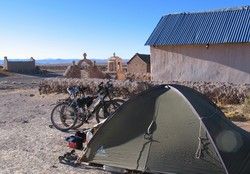 Sonja and Ludgardo part 2: The
next morning brings and Sonja a freshly fried bread for the breakfast
to the tent and mean, nevertheless, we should stay here one more day
and rest a little. Now we are in the catch-22 situation. Loving with
pleasure we would spend one more day with Sonja and her family, however,
on no account we want to lie to them on the pocket and allow to feed
us again from them. Now ordinarily we would offer that we would cook
today for everybody, however, our stocks of food are limited just
more than only. We could still exchange no money and have no Boliviano
in the pocket, and up to the next place where we hopefully on a bank
hit these are still more than 150 km on grit runways. We have to eat
just enough that we if everything well runs these can reach. Should
we need, nevertheless, longer than two days would be fast announced.
Long we turn over in the mind and, nevertheless, finally, we decide
in addition to go on. The resignation hurts, in particular, because
Sonja tells us that we were the first guests in her life. Sonja and Ludgardo part 2: The
next morning brings and Sonja a freshly fried bread for the breakfast
to the tent and mean, nevertheless, we should stay here one more day
and rest a little. Now we are in the catch-22 situation. Loving with
pleasure we would spend one more day with Sonja and her family, however,
on no account we want to lie to them on the pocket and allow to feed
us again from them. Now ordinarily we would offer that we would cook
today for everybody, however, our stocks of food are limited just
more than only. We could still exchange no money and have no Boliviano
in the pocket, and up to the next place where we hopefully on a bank
hit these are still more than 150 km on grit runways. We have to eat
just enough that we if everything well runs these can reach. Should
we need, nevertheless, longer than two days would be fast announced.
Long we turn over in the mind and, nevertheless, finally, we decide
in addition to go on. The resignation hurts, in particular, because
Sonja tells us that we were the first guests in her life. |
| |
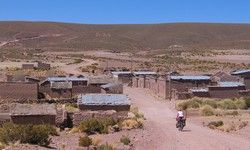 Other detours: From Sonja and Ludgardo
from we follow a sandy however well to be driven runway to the north,
however, to us, finally, again on the right street are we must cycle
once again own kilometres more than we had expected. Nevertheless,
expected good Schotterstrasse is a bad washing board runway from very
coarse grit, so that we make headway rather laboriously. Nevertheless,
bit by bit the street very feels well better and, finally, even here
and there. In Tambo Tambillo we fill in our stores of water in the
village well from which with the help of an old Belchkiste the water
is scooped. The people here on the Altiplano are nice, by the way,
everybody really and friendly. From a driver we get as a gift even
bread, fancy cakes and biscuits and want to invite once to us a few
construction workers to food, (nevertheless, to us have got what they,
actually, want we are already vorbeigeradelt). Then to Santuario de
Quillacas the street becomes once again bad. There comes that there
is a new street here either again, or our map is once again wrong,
because 20 km farther to the south instead of directly in Santiago
de Huari we come out; with the taut headwind we have more than only
one cat's jump once again. Briefly before we after many kilometres
in dust and mud again on the tarred road come Nadine has one more
spoke break. Apparently the mechanic does not have in Salta, nevertheless,
so well eingespeicht. Other detours: From Sonja and Ludgardo
from we follow a sandy however well to be driven runway to the north,
however, to us, finally, again on the right street are we must cycle
once again own kilometres more than we had expected. Nevertheless,
expected good Schotterstrasse is a bad washing board runway from very
coarse grit, so that we make headway rather laboriously. Nevertheless,
bit by bit the street very feels well better and, finally, even here
and there. In Tambo Tambillo we fill in our stores of water in the
village well from which with the help of an old Belchkiste the water
is scooped. The people here on the Altiplano are nice, by the way,
everybody really and friendly. From a driver we get as a gift even
bread, fancy cakes and biscuits and want to invite once to us a few
construction workers to food, (nevertheless, to us have got what they,
actually, want we are already vorbeigeradelt). Then to Santuario de
Quillacas the street becomes once again bad. There comes that there
is a new street here either again, or our map is once again wrong,
because 20 km farther to the south instead of directly in Santiago
de Huari we come out; with the taut headwind we have more than only
one cat's jump once again. Briefly before we after many kilometres
in dust and mud again on the tarred road come Nadine has one more
spoke break. Apparently the mechanic does not have in Salta, nevertheless,
so well eingespeicht. |
| |
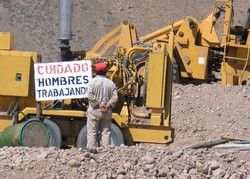 Cuidado Hombres Trabajando! Attention:
Men at the work!!! Cuidado Hombres Trabajando! Attention:
Men at the work!!! |
| |
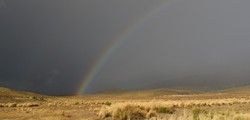 Thunderstorm: Actually, wants to fill in we even today
in Challapata our stores of water and exchange, finally, money, however,
3 km before Challapata we are stopped by a gigantic thunderstorm with
Hagel and properly a lot of rain and can just still creep away on
time in our tent. Behind the wall there is a small well from Nadine
then luckily some waters (rather brownishly) can get, before the thunderstorm
properly gets cracking. Thunderstorm: Actually, wants to fill in we even today
in Challapata our stores of water and exchange, finally, money, however,
3 km before Challapata we are stopped by a gigantic thunderstorm with
Hagel and properly a lot of rain and can just still creep away on
time in our tent. Behind the wall there is a small well from Nadine
then luckily some waters (rather brownishly) can get, before the thunderstorm
properly gets cracking. |
| |
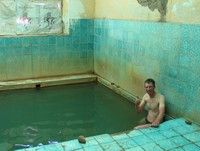 Thermal baths: In Pazña there should
be thermal baths, and thus we ask a few locals where we them then
would find. We find out that there should be here two thermal baths.
Next on the street to the north and another with the name Urizza in
the other direction. The thermal bath Urizza should be the nicer one
and thus we follow the council of the Bolivians. Like himself then,
nevertheless, puts outside the thermal bath of Urizza 6 km lies outside
from Pazña namely of a grit runway uphill after behind a small
place. The thermal bath of Urizza belongs to a mine and a mine worker
with yellow protective helmet assigns our own bath in a little bit
ramshackle building to us. Nevertheless, differently than in other
thermal baths the sense seems here to be to be able to wash sometimes
with warm water because to use in spite of signs no shampoo some Schampootüten
lie around here. We rush in the floods and enjoy the nice hot water
to us, finally, completely schrumpelige skin have. Almost we would
have even forgotten to pay, because the mine worker with no tone has
mentioned an entry fee and the layout also worked rather in such a
way, as if she was intended for the mine workers and their families.
Also when we we of the mine worker dismiss he still says nothing,
however, as us hard waving over again in him drive past suddenly occurs
to him that he has forgotten what. Thermal baths: In Pazña there should
be thermal baths, and thus we ask a few locals where we them then
would find. We find out that there should be here two thermal baths.
Next on the street to the north and another with the name Urizza in
the other direction. The thermal bath Urizza should be the nicer one
and thus we follow the council of the Bolivians. Like himself then,
nevertheless, puts outside the thermal bath of Urizza 6 km lies outside
from Pazña namely of a grit runway uphill after behind a small
place. The thermal bath of Urizza belongs to a mine and a mine worker
with yellow protective helmet assigns our own bath in a little bit
ramshackle building to us. Nevertheless, differently than in other
thermal baths the sense seems here to be to be able to wash sometimes
with warm water because to use in spite of signs no shampoo some Schampootüten
lie around here. We rush in the floods and enjoy the nice hot water
to us, finally, completely schrumpelige skin have. Almost we would
have even forgotten to pay, because the mine worker with no tone has
mentioned an entry fee and the layout also worked rather in such a
way, as if she was intended for the mine workers and their families.
Also when we we of the mine worker dismiss he still says nothing,
however, as us hard waving over again in him drive past suddenly occurs
to him that he has forgotten what. |
| |
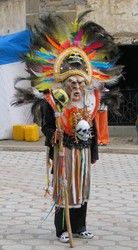 Festival in Pazña: Fresh washed
we come just on time back to Pazña around a festival move are
present to skill which just takes place here. Pazña lies about
80 km to the south of Oruro which is famous for his carnival and in
particular for the costly and imposing masks. Apparently some teams
from Oruro have also come here, many of the absolutely impressive
masks could come just as well from a star War Film. Festival in Pazña: Fresh washed
we come just on time back to Pazña around a festival move are
present to skill which just takes place here. Pazña lies about
80 km to the south of Oruro which is famous for his carnival and in
particular for the costly and imposing masks. Apparently some teams
from Oruro have also come here, many of the absolutely impressive
masks could come just as well from a star War Film. |
| |
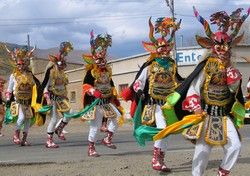 Dance teams: During just two hours we admire
the move, the coloured activity and the wild dances. On the marketplace
a big rostrum is built up on one jury sits which values the dance
presentations of the single teams. In the late afternoon we see all
at once in the horizon again drawing up thick storm clouds and get
on the way as soon as possible again. Then on the Rau's way we hit
not only on even other dance teams which just prepare themselves but
directly behind the place on the other thermal bath in a nice relatively
new building. Dance teams: During just two hours we admire
the move, the coloured activity and the wild dances. On the marketplace
a big rostrum is built up on one jury sits which values the dance
presentations of the single teams. In the late afternoon we see all
at once in the horizon again drawing up thick storm clouds and get
on the way as soon as possible again. Then on the Rau's way we hit
not only on even other dance teams which just prepare themselves but
directly behind the place on the other thermal bath in a nice relatively
new building. |
| |
|
|
I
BOOKLET
available
for
DONATION!

50pages, 80 b/w photos, background
infos, stories, ...
Just send your donation
to our
Pay
Pal account: nadinepuschkasch@yahoo.de
and email us your post
address and we´ll send it to you.
|
| |
| |
|
Like to place your Ad here?
Just e-mail to:
martinlunz@yahoo.de
|
| |
| |
|
You
liked our website and like to contribute?
Our Pay
Pal account is: nadinepuschkasch@yahoo.de
|
|
| |
|
